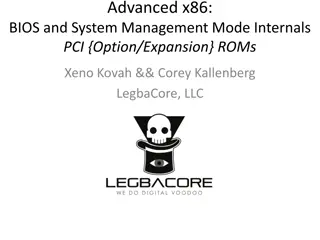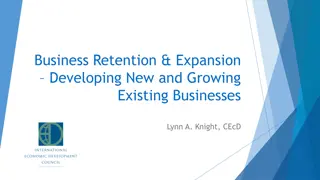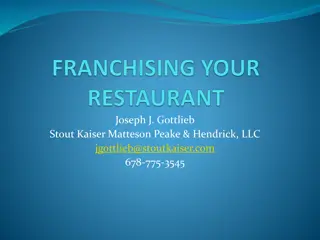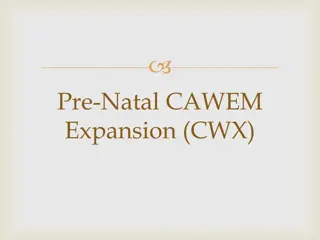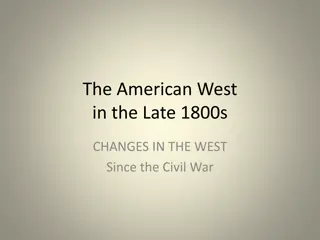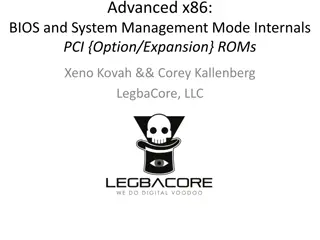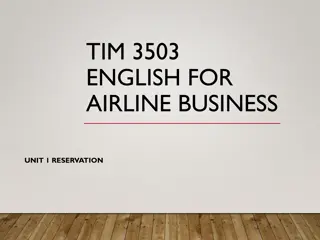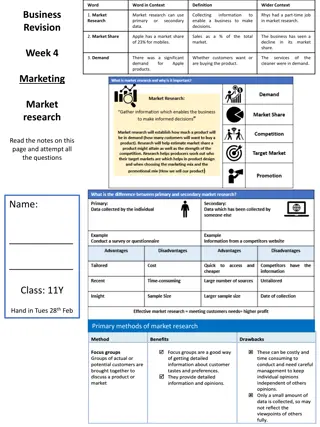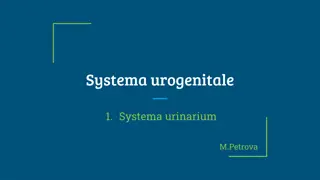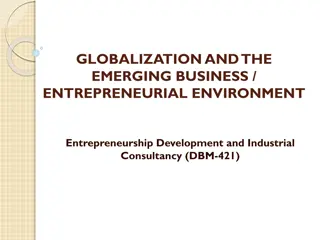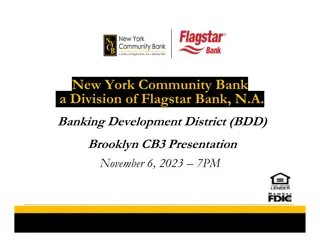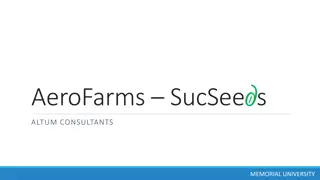Methods of Business Expansion and Key Terms Explained
Methods of business expansion can be organic or inorganic, with inorganic methods including strategic alliances, mergers, and takeovers. Key terms such as inorganic growth, joint ventures, acquisitions, and subsidiaries are crucial for understanding business expansion strategies.
Download Presentation

Please find below an Image/Link to download the presentation.
The content on the website is provided AS IS for your information and personal use only. It may not be sold, licensed, or shared on other websites without obtaining consent from the author. Download presentation by click this link. If you encounter any issues during the download, it is possible that the publisher has removed the file from their server.
E N D
Presentation Transcript
//18 BUSINESS EXPANSION
Topic: Chapter 18 - Business Expansion Learning Intentions Learning Intentions To be able to: Explain what the methods of business Expansion are.
https://www.mentimeter.com/s/af8e6cd371 133587fe4807e78204a938/c5f919fe69c2
REASONS FOR BUSINESS EXPANSION Key Terms Inorganic growth, strategic business alliance/joint venture, merger, takeover/acquisition, holding company, subsidiary
Inorganic Methods of BUSINESS EXPANSION Inorganic growth is the external growth of a business. A business can decide to expand inorganically through: a strategic business alliance/joint venture a merger a takeover/acquisition.
1. Strategic business alliance/joint venture A strategic business alliance/joint venture is when two or more independent businesses agree to co-operate and share resources and expertise for the mutual benefit of all parties involved. The businesses remain legally independent and each business maintains its own separate trading identity. Either party can end the arrangement easily if they choose. Glanbia has four strategic joint ventures and associates: Southwest Cheese in the US, Glanbia Cheese in the UK, Glanbia Ireland and Glanbia Cheese EU based in Ireland.
2. Merger A merger is a voluntary amalgamation of two or more businesses for their mutual benefit, trading under a common name. A single new legal entity is formed once it is approved by shareholders. For example, Avonmore Co-op and Waterford Foods merged to form Glanbia plc.
3. Takeover/acquisition A takeover/acquisition occurs when one business purchases 51% or more of the shares in another business in either a hostile or friendly manner. The acquiring business, known as the holding company, obtains control of the other business, which is known as the subsidiary. The subsidiary could lose its identity after the acquisition and become part of the acquiring business. A takeover can be very expensive. For example, Google acquired the popular online video site YouTube for $1.65 billion and Motorola Mobility, a mobile device manufacturing company, for $12.5 billion.
https://www.tutor2u.net/economics/bl og/recent-examples-of-corporate- takeovers-and-mergers
https://play.kahoot.it/#/?quizId=0f8ad0bb- 4567-4921-91e3-3a74a7cbc532
Think Tank (a) Explain the term business alliance . (b) Illustrate the advantages of an alliance as a form of business expansion. (20 marks) 2009 HL Q5 (a) long (a) A strategic business alliance/joint venture is when two or more independent businesses agree to co-operate and share resources and expertise for the mutual benefit of all parties involved. The businesses remain legally independent and each business maintains its own separate trading identity. Either party can end the arrangement easily if they choose. Glanbia has four strategic joint ventures and associates: Southwest Cheese in the US, Glanbia Cheese in the UK, Glanbia Ireland and Glanbia Cheese EU based in Ireland. (See next slide)
Think Tank (a) Explain the term business alliance . (b) Illustrate the advantages of an alliance as a form of business expansion. (20 marks) 2009 HL Q5 (a) long b) Cost-effective: Resources are shared and associated costs are divided between partners. Shared resources and expertise: Resources and expertise can be recruited through alliance a lack of resources or expertise need not be an obstacle to expansion. Market access: Both businesses gain access to new markets. For example, Guinness and Newbridge Silverware have a joint jewellery and homeware collection. Guinness is marketed to customers of Newbridge Silverware, while Newbridge Silverware is marketed to Guinness customers.
Think Tank Define inorganic growth. Inorganic growth is the external growth of a business. A business can decide to expand inorganically through: a strategic business alliance/joint venture; a merger; a takeover/acquisition.
Think Tank Explain three methods of inorganic growth. A strategic business alliance/joint venture is when two or more independent businesses agree to co-operate and share resources and expertise for the mutual benefit of all parties involved. The businesses remain legally independent and each business maintains its own separate trading identity. Either party can end the arrangement easily if they choose. Glanbia has four strategic joint ventures and associates: Southwest Cheese in the US, Glanbia Cheese in the UK, Glanbia Ireland and Glanbia Cheese EU based in Ireland. A merger is a voluntary amalgamation of two or more businesses for their mutual benefit, trading under a common name. A single new legal entity is formed once it is approved by shareholders. For example, Avonmore Co-op and Waterford Foods merged to form Glanbia plc. A takeover/acquisition occurs when one business purchases 51% or more of the shares in another business in either a hostile or friendly manner. The acquiring business, known as the holding company, obtains control of the other business, which is known as the subsidiary. The subsidiary could lose its identity after the acquisition and become part of the acquiring business. A takeover can be very expensive. For example, Google acquired the popular online video site YouTube for $1.65 billion.
Think Tank Distinguish between a merger and a strategic business alliance. A strategic business alliance/joint venture is when two or more independent businesses agree to co- operate and share resources and expertise for the mutual benefit of all parties involved. The businesses remain legally independent and each business maintains its own separate trading identity. However, in a merger two or more businesses amalgamate and a single new legal entity is formed (once it is approved by shareholders).
Think Tank Outline the disadvantages of a merger as a form of business expansion. Redundancies: When businesses merge, redundancies can result, e.g. the new merged entity now has one HR manager too many. Restructuring, redundancies or industrial relations problems can occur. Conflict: Differing organisational cultures can lead to conflict between management teams, who have their own management styles and systems. A newly merged entity may struggle with low trust and decision making. Communication: New colleagues come from differing work cultures and are used to differing work practices. Resistance to change and fear of job loss may be additional factors in low morale or interpersonal conflicts.
Think Tank Describe what is meant by a takeover. Illustrate the advantages of a takeover as a form of business expansion. A takeover/acquisition occurs when one business purchases 51% or more of the shares in another business in either a hostile or friendly manner. The acquiring business, known as the holding company, obtains control of the other business, which is known as the subsidiary. The subsidiary could lose its identity after the acquisition and become part of the acquiring business. Advantages: Economies of scale costs will be lower if a business takes over another business, especially if both businesses are in the same industry. Increased target market the holding company now has access to a whole new market segment. Diversification a business can diversify into new products, thereby reducing its risk.






